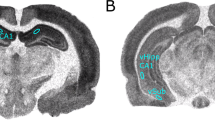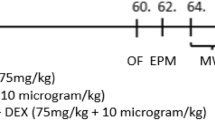Abstract
Rationale
Epilepsy is a debilitating seizure disorder that affects approximately 50 million people. Noradrenaline reduces neuronal excitability, has anticonvulsant effects and is protective against seizure onset.
Objective
We investigated the role of α2-adrenoceptors in vivo in a neonatal domoic acid (DOM) rat model of epilepsy.
Methods
We injected male Sprague-Dawley rats daily from postnatal day 8–14 with saline or one of two sub-convulsive doses, 20 μg/kg (DOM20) or 60 μg/kg (DOM60) DOM, an AMPA/kainate receptor agonist. The rats were observed in open field, social interaction and forced swim tests at day 50, 75 and 98, respectively. At ~120 days of age, four rats per group were injected and scanned with [11C]yohimbine, an α2-adrenoceptor antagonist, and scanned in a Mediso micro positron emission tomography (PET) scanner to measure α2−adrenoceptor binding.
Results
DOM60-treated rats spent more time in the periphery during the open field test and had a significant 26–33 % reduction in [11C]yohimbine binding in the hypothalamus, hippocampus and orbital prefrontal cortex compared to saline-treated rats. On the other hand, DOM20 rats had a significant 34–40 % increase in [11C]yohimbine binding in the hypothalamus, amygdala and entorhinal cortex compared to saline-treated rats, with no obvious behavioural differences.
Conclusions
The current data clearly indicate that low concentrations of DOM given to rats in their second week of life induces long-term changes in α2-adrenoceptor binding in rat brain that may have relevance to the progression of an epilepsy phenotype.



Similar content being viewed by others
References
Arnsten AF, Scahill L, Findling RL (2007) Alpha2-adrenergic receptor agonists for the treatment of attention-deficit/hyperactivity disorder: emerging concepts from new data. Journal of child and adolescent psychopharmacology 17:393–406
Barry DI, Kikvadze I, Brundin P, Bolwig TG, Bjorklund A, Lindvall O (1987) Grafted noradrenergic neurons suppress seizure development in kindling-induced epilepsy. Proc Natl Acad Sci U S A 84:8712–8715
Bernard PB, Macdonald DS, Gill DA, Ryan CL, Tasker RA (2007) Hippocampal mossy fiber sprouting and elevated trkB receptor expression following systemic administration of low dose domoic acid during neonatal development. Hippocampus 17:1121–1133
Boron W, Boulpaep E (2009a) Medical physiology: a cellular and molecular approach, chapter 13, second edn. Saunders, Elsevier
Boron W, Boulpaep E (2009b) Medical physiology: a cellular and molecular approach, chapter 14. Saunders, Elsevier
Briere R, Sherwin AL, Robitaille Y, Olivier A, Quesney LF, Reader TA (1986) Alpha-1 adrenoceptors are decreased in human epileptic foci. Ann Neurol 19:26–30
Doucette TA, Strain SM, Allen GV, Ryan CL, Tasker RA (2000) Comparative behavioural toxicity of domoic acid and kainic acid in neonatal rats. Neurotoxicol Teratol 22:863–869
Doucette TA, Bernard PB, Husum H, Perry MA, Ryan CL, Tasker RA (2004) Low doses of domoic acid during postnatal development produce permanent changes in rat behaviour and hippocampal morphology. Neurotox Res 6:555–563
Doucette TA, Ryan CL, Tasker RA (2007) Gender-based changes in cognition and emotionality in a new rat model of epilepsy. Amino acids 32:317–322
Gill DA, Bastlund JF, Watson WP, Ryan CL, Reynolds DS, Tasker RA (2010) Neonatal exposure to low-dose domoic acid lowers seizure threshold in adult rats. Neuroscience 169:1789–1799
Gill DA, Perry MA, McGuire EP, Perez-Gomez A, Tasker RA (2012) Low-dose neonatal domoic acid causes persistent changes in behavioural and molecular indicators of stress response in rats. Behav Brain Res 230:409–417
Gloor P, Pellegrini A, Kostopoulos GK (1979) Effects of changes in cortical excitability upon the epileptic bursts in generalized penicillin epilepsy of the cat. Electroencephalogr Clin Neurophysiol 46:274–289
Hein L, Altman JD, Kobilka BK (1999) Two functionally distinct alpha2-adrenergic receptors regulate sympathetic neurotransmission. Nature 402:181–184
Hiramatsu M, Fujimoto N, Mori A (1982) Catecholamine level in cerebrospinal fluid of epileptics. Neurochem Res 7:1299–1305
Jakobsen S, Pedersen K, Smith DF, Jensen SB, Munk OL, Cumming P (2006) Detection of alpha2-adrenergic receptors in brain of living pig with 11C-yohimbine. Journal of nuclear medicine: official publication, Society of Nuclear Medicine 47:2008–2015
Jefferys JGR, Jiruska P, de Curtis M, Avoli M (2012) Limbic network synchronization and temporal lobe epilepsy. In: Noebels JL, Avoli M, Rogawski MA, Olsen RW, Delgado-Escueta AV (eds) Jasper’s Basic Mechanisms of the Epilepsies, Bethesda (MD)
Landau AM, Dyve S, Jakobsen S, Alstrup AK, Gjedde A, Doudet DJ (2015a) Acute vagal nerve stimulation lowers alpha2 adrenoceptor availability: possible mechanism of therapeutic action. Brain stimulation
Landau AM, Phan JA, Iversen P, Lillethorup TP, Simonsen M, Wegener G, Jakobsen S, Doudet DJ (2015b) Decreased in vivo alpha2 adrenoceptor binding in the Flinders Sensitive Line rat model of depression. Neuropharmacology 91:97–102
Landau AM, Doudet DJ, Jakobsen S (2012) Amphetamine challenge decreases yohimbine binding to alpha2 adrenoceptors in Landrace pig brain. Psychopharmacology 222:155–163
Liu D, Caldji C, Sharma S, Plotsky PM, Meaney MJ (2000) Influence of neonatal rearing conditions on stress-induced adrenocorticotropin responses and norepinepherine release in the hypothalamic paraventricular nucleus. J Neuroendocrinol 12:5–12
Loscher W, Czuczwar SJ (1987) Comparison of drugs with different selectivity for central alpha 1-and alpha 2-adrenoceptors in animal models of epilepsy. Epilepsy Res 1:165–172
Marriott AL, Ryan CL, Doucette TA (2012) Neonatal domoic acid treatment produces alterations to prepulse inhibition and latent inhibition in adult rats. Pharmacol Biochem Behav 103:338–344
Marriott AL, Tasker RA, Ryan CL, Doucette TA (2014) Neonatal domoic acid abolishes latent inhibition in male but not female rats and has differential interactions with social isolation. Neurosci Lett 578:22–26
McIntyre DC, Wong RK (1986) Cellular and synaptic properties of amygdala-kindled pyriform cortex in vitro. J Neurophysiol 55:1295–1307
Moy SS, Nadler JJ, Perez A, Barbaro RP, Johns JM, Magnuson TR, Piven J, Crawley JN (2004) Sociability and preference for social novelty in five inbred strains: an approach to assess autistic-like behavior in mice. Genes Brain Behav 3:287–302
Pearce HL, Safa AR, Bach NJ, Winter MA, Cirtain MC, Beck WT (1989) Essential features of the P-glycoprotein pharmacophore as defined by a series of reserpine analogs that modulate multidrug resistance. Proc Natl Acad Sci U S A 86:5128–5132
Phan JA, Landau AM, Wong DF, Jakobsen S, Nahimi A, Doudet DJ, Gjedde A (2015) Quantification of [(11)C]yohimbine binding to alpha2 adrenoceptors in rat brain in vivo. Journal of cerebral blood flow and metabolism: official journal of the International Society of Cerebral Blood Flow and Metabolism 35:501–511
Porsolt RD, Le Pichon M, Jalfre M (1977) Depression: a new animal model sensitive to antidepressant treatments. Nature 266:730–732
Raedt R, Clinckers R, Mollet L, Vonck K, El Tahry R, Wyckhuys T, De Herdt V, Carrette E, Wadman W, Michotte Y, Smolders I, Boon P, Meurs A (2011) Increased hippocampal noradrenaline is a biomarker for efficacy of vagus nerve stimulation in a limbic seizure model. J Neurochem 117:461–469
Ryan CL, Robbins MA, Smith MT, Gallant IC, Adams-Marriott AL, Doucette TA (2011) Altered social interaction in adult rats following neonatal treatment with domoic acid. Physiol Behav 102:291–295
Scheinin M, Lomasney JW, Hayden-Hixson DM, Schambra UB, Caron MG, Lefkowitz RJ, Fremeau RT Jr (1994) Distribution of alpha 2-adrenergic receptor subtype gene expression in rat brain. Brain Res Mol Brain Res 21:133–149
Starke K, Gothert M, Kilbinger H (1989) Modulation of neurotransmitter release by presynaptic autoreceptors. Physiol Rev 69:864–989
U’Prichard DC, Snyder SH (1979) Distinct alpha-noradrenergic receptors differentiated by binding and physiological relationships. Life Sci 24:79–88
Wang Y, Liu J, Gui ZH, Ali U, Fan LL, Hou C, Wang T, Chen L, Li Q (2011) Alpha2-adrenoceptor regulates the spontaneous and the GABA/glutamate modulated firing activity of the rat medial prefrontal cortex pyramidal neurons. Neuroscience 182:193–202
WHO (2006) Neurological disorders: public health challenges. World Health Organization, Geneva
Acknowledgments
The authors thank the staff at the PET Centre and Translational Neuropsychiatric Unit at Aarhus University and Hospital. Special thanks to Jenny-Ann Phan for help with the free fraction method and Kim Vang for help with image analysis.
Author information
Authors and Affiliations
Corresponding author
Ethics declarations
All animal procedures were approved by the Danish Committee on Ethics in Animal Experimentation.
Conflict of interest
ᅟ
The authors declare that they have no conflict of interest.
ᅟ
Funding
This study was supported by the Lundbeck Foundation grant number 2013–14,933 to G.W and R.A.T. and the Aarhus PET Centre.
Rights and permissions
About this article
Cite this article
Thomsen, M.B., Lillethorup, T.P., Jakobsen, S. et al. Neonatal domoic acid alters in vivo binding of [11C]yohimbine to α2-adrenoceptors in adult rat brain. Psychopharmacology 233, 3779–3785 (2016). https://doi.org/10.1007/s00213-016-4416-5
Received:
Accepted:
Published:
Issue Date:
DOI: https://doi.org/10.1007/s00213-016-4416-5




